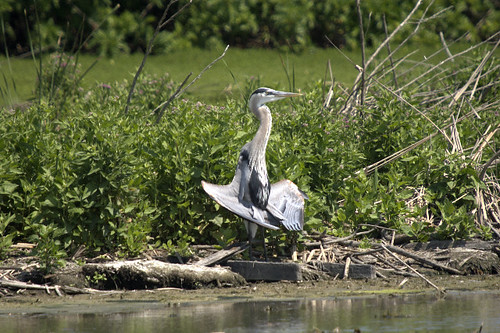tags: great blue heron, Ardea herodias, birds, Image of the Day
Great Blue Heron, Ardea herodias, engaging in peculiar behavior at the Port Aransas Birding Center, Texas.
Image: Scott Lewis [larger view].
Does anyone know the purpose for this behavior?
More like this
tags: Great Blue Heron, Ardea herodias,
tags: great blue heron, Ardea herodias, birds
It's well known that herons are gluttonous birds that will catch and eat (or try to eat) pretty much any animal within the right size range.


Is there a context? Movement? My first guess would be simple sunning, especially if the heron had just been in the water. The shadow certainly seems to show orientation toward the sun.
I've seen this a few times while canoeing in Ontario. My first association was with a cool late-summer day, and so I'd guess sunning/warming.
Warming the undersides of his wings.
The sunning/warming guess seems likely to be right, but it would depend on the time of year. Texas along the coast is vwry warm most of the year, and birds would not need to warm up.
My guess was the heron accidentally got wet and was trying to dry itself, like cormorants do.
Isn't it obvious that this is a classic Heron Yoga pose? Clearly this bird is demonstrating "tree pose" and doing a nice job of it too.
It reminds me a bit of the horaltic pose buzzards do (er, turkey vultures, I mean) which is thought to be for drying the wings or warming up the body. I have no idea if herons do that regularly, or at all, though.
Ridger
Interesting that you would use the word "horaltic"; there was a recent discussion on BirdChat about this word, which was new to me.
It turns out, if you read the comments on the site, that this word is probably just a mumbled offspring (mumpsimus) of the word "heraldic", or spread-eagled.
Last month (Oct 2007) in Brazil, it was an attitude I could observe regularly - I'd say once per day - for great blues, Cocois, etc.
For me, it looks a lot like the Cormoran sunning to dry their wings. But I don't have proof of that.
The other possibility is that the bird was trying to improve its sun tan on the lower part of the peak, but this would only be a wild guess (a wild life guess)...
Yep simple case of sunning behavior. Surprised you seem to think it's unusual? That's exactly how they sun & do it pretty often.. have seen pictures like that many times, even personal pictures from friends.
I think the reason birds sun is because it feels good, the advantages are varied- drying off, parasite control, straightening out feathers(seems the primary one for soaring birds- their primaries get bent from the constant soaring. Heat straightens them out again). But in the end, they do it because it feels good.
It still can be sunning, whether it is cold/warm or even hot. I have hundreds of different outdoor birds(ranging from finches, parrots game birds, peafowl, poultry), ALL of them engage in sunning behavior during the summertime.. which reaches 110-120 degrees F. So I disagree whenever people say it can't be sunning behavior if it's during a hot day.
Our local turkey buzzards sun their wings on the top side as that is where the darker feathers are located. Our mourning doves love to lay one wing out at a time in the shade, possibly cooling them since it is usually about 90 degrees out when we see this behavior.
they do this to remove mites the heat from the sun kills the mites